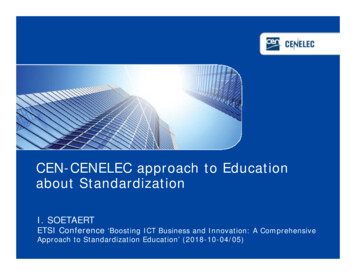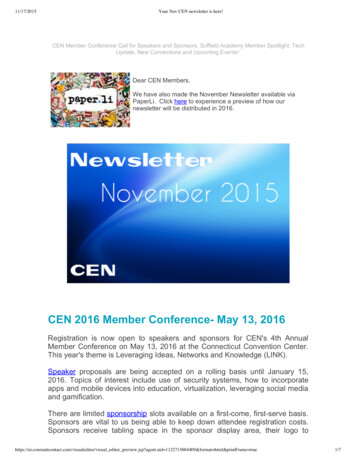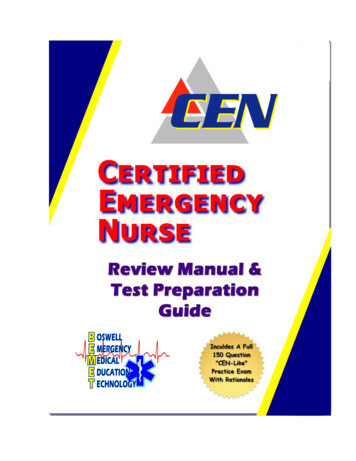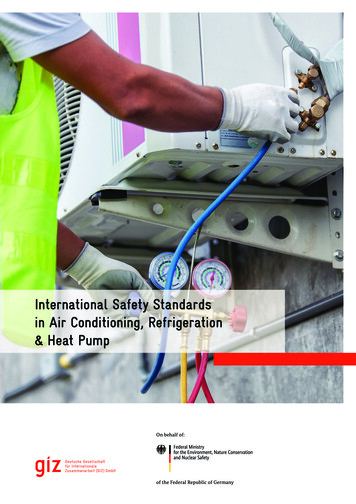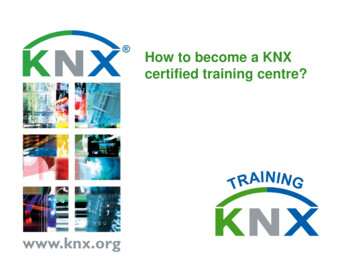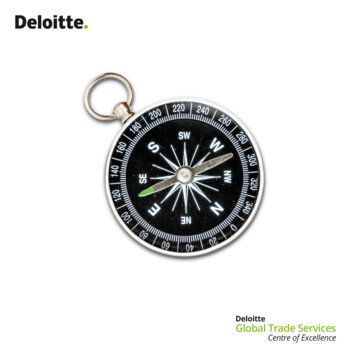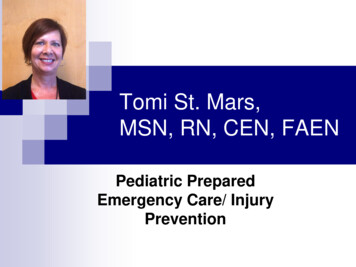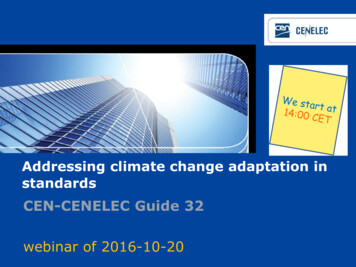
Transcription
Addressing climate change adaptation instandardsCEN-CENELEC Guide 32webinar of 2016-10-20
Addressing climate change adaptationin standardsWELCOME !Get the most out of the webinar today Turn off email, phones, instant messaging tools Get involved:Use the Q&A panel to submit yourwritten questions Please take the Exit surveyclimate webinar of 2016-10-20 CEN-CENELEC 2016 - 2
Addressing climate change adaptation instandardsclimate webinar of 2016-10-20 CEN-CENELEC 2016 - 3
Addressing climate change adaptation instandardsYour presentersKay JOHNSTONEConvenorClimate Project TeamAndrea NAMProgramme ManagerSustainability & Services Unitclimate webinar of 2016-10-20George PAUNESCUPolicy Officer - AdaptationClimate Action DGEuropean Commission CEN-CENELEC 2016 - 4
Addressing climate change adaptation instandardsContent Reasons for the development of theguideClimate change and its impactsrelated to European standardization The European Strategy Challenges & opportunitiesHow to use the CEN-CENELEC Guide32? The guide step by step ExamplesKey learning pointsQ&A CEN-CENELEC 2016 - 5
The rationale of the development of the guideclimate webinar of 2016-10-20 CEN-CENELEC 2016 - 6
The climate is changing The current global average temperature is 0.85ºC higher than it was in the late19th century. In recent decades, changes in climate have caused impacts on all continentsand oceans. Climate change is due to human activity (IPCC report findings) If we carry on without addressing it sufficiently, we risk increasingly severeand irreversible impacts:»»»» rising seas,increasingly severe droughts and floods,food and water shortages,extreme events etc.If we reduce the anthropogenic emissions of greenhouse gases, manyassociated impacts of climate change will still persist for centuries (IPCC).climate webinar of 2016-10-20 CEN-CENELEC 2016 - 7
What can be done? Strategies for reducing and managing the risks ofclimate change: Mitigation - dealing with the causes of climatechange by reducing emissions. Adaptation - dealing with the unavoidable impactsof climate change. Adaptation and mitigation are complementaryclimate webinar of 2016-10-20 CEN-CENELEC 2016 - 8
How to adapt?Adaptation anticipating the adverse effects of climate changetaking appropriate action to prevent or minimisethe damage they can cause ortaking advantage of opportunities that may ariseAdaptation in standardization Mainstream adaptation considerations in keyvulnerable sectors Energy, Transport ConstructionEnsuring more resilient infrastructure - a long lifespan and high costsDevelop new standards and/or revise standardsclimate webinar of 2016-10-20 CEN-CENELEC 2016 - 9
The rationale of the development of the Guide EU Strategy on adaptation to climate change - COM(2013) 216 final CEN/SABE initiative - development of a supplement to CEN Guide 4“Guide for addressing environmental issues in product standards (2008)” Commission Implementing Decision C(2014) 3451 final or M/526 ‘Standardisation request to the European standardisation organisations insupport of implementation of the EU Strategy on Adaptation to ClimateChange’ – standards in the priority sectors and guide on adaptation CEN/SABE Climate Project Team involving CENELEC CEN-CENELEC Guide 32 “Guide for addressing climate changeadaptation in standards” – published in April 2016 CEN-CENELEC Guide 32 – offered to ISO and IECclimate webinar of 2016-10-20 CEN-CENELEC 2016 - 10
Climate change and its impacts related toEuropean standardizationclimate webinar of 2016-10-20 CEN-CENELEC 2016 - 11
Vulnerable Europe- The EU is alreadyfacing unavoidableimpacts of climatechange- Impacts will affectthe full EU territory,with regionaldifferences- Average andextreme temperaturesincreases; changesin precipitation andflood patterns; moreintense windstorms;droughts; sea levelrise; coastal erosion;landslides etc. CEN-CENELEC 2016 - 12
Climate changeSlow on-set climate changemean temp.Extreme weather eventsextreme daily temp.ENSEMBLES regional climate model 2016-2035 vs. 1986-2005Source: Joint Research Centre, ECAndrea NAMclimate webinar of 2016-10-20Changes in extreme climatic events CEN-CENELEC 2016 - 13
ImpactsAndrea NAMclimate webinar of 2016-10-20 CEN-CENELEC 2016 - 14 IStock
Impacts oninfrastructure"Potential damagefrom climate hazardsto criticalinfrastructures in theenergy, transport,industrial and socialsector could triple bythe 2020s, multiplysix-fold by midcentury, and surpass10 times today’s totalof 3.4 billion /yearby the end of the 21stcentury"Source:JRC Technical Report"Resilience of largeinvestments and criticalinfrastructures in Europeto climate change"Andrea NAMclimate webinar of 2016-10-20 CEN-CENELEC 2016 - 15
EU Strategy on adaptation to climate changePriority 1: Promoting action by Member StatesAction 1.Encourage MS to adopt Adaptation Strategies andaction plansAction 2.LIFE funding, including adaptation priority areasAction 3.Promoting adaptation action by cities along theCovenant of Mayors initiativePriority 2: Better informed decision-makingAction 4.Knowledge-gap strategyAction 5.Climate-ADAPTPriority 3: Adaptation in key vulnerable sectorsAction 6.Climate proofing the Common Agricultural Policy,Cohesion Policy, and the Common Fisheries PolicyAction 7.Making infrastructure more resilientAction8.Andrea NAMPromote products & services by insurance andfinance marketsclimate webinar of 2016-10-20 CEN-CENELEC 2016 - 16
Climate change adaptation in standardizationChallenges & opportunitiesChallenges Inherent uncertainties about future climate conditions should not prevent suitable action being taken nowNew topic being brought to the attention of standardisationOpportunities Operational framework - ongoing work on the Mandate M/526 Coordination Group on Adaptation to Climate Change (ACC-CG) CEN-CENELEC Guide 32 Synergies with the Mandate M/515 (Eurocodes) Building synergies with the work of ISOPolicy framework – strong support EU Strategy on Adaptation to Climate Change Paris Agreement – impetus for adaptationWider context of infrastructure resilience to climate change EUFIWACC Guidanceclimate webinar of 2016-10-20 CEN-CENELEC 2016 - 17
Further information: DG Clima web /index en.htm Climate-ADAPThttp://climate-adapt.eea.europa.eu/ JRC study on resilience of EU ransport-and-energyinfrastructure EUFIWACC s/integratingclimate change en.pdfAndrea NAMclimate webinar of 2016-10-20 CEN-CENELEC 2016 - 18
The CEN-CENELEC Guide 32 guide step by stepHow to translate it to your work?climate webinar of 2016-10-20 CEN-CENELEC 2016 - 19
The purpose and scope of Guide 32Guide 32 is intended to:- help standards writersidentify relevantclimate impacts andinclude adaptationconsiderations in newor revised standardsclimate webinar of 2016-10-20 CEN-CENELEC 2016 - 20
The purpose and scope of Guide eresilienceproducts’climate webinar of 2016-10-20Products:- material products; services;test methods; infrastructureClimate influenced products:- fitness for purpose may beaffected if climate is ignoredClimate resilience products:- main aim is to reducevulnerability CEN-CENELEC 2016 - 21
The purpose of Guide 32But it is not intendedto:- be a guide toadaptation (more thanstandards)- lead tostandardization in thelevel of risk thatorganisations orindividuals acceptclimate webinar of 2016-10-20 CEN-CENELEC 2016 - 22
How to use Guide 32GettingStartedExploreclimateimpactsPlan yourapproachclimate webinar of 2016-10-20 Determine whether it is relevant using initialchecklist (5.1) Background reading (introduction and Annex A) Use section 4.3 to identify potential climaterelated impacts on the use stage Read section 3.6 and identify any systemicimpacts Use decision tree & checklist to tailor theapproach (5.2) Refer to Sections 3 & 4 in support of any plannedaction CEN-CENELEC 2016 - 23
Getting startedChecklist- A set of simple yes/ no questions- Will determine whether issue is relevantBackground reading to understand:- The need to adapt- The key issues in Europeclimate webinar of 2016-10-20 CEN-CENELEC 2016 - 24
Exploring relevant climate impacts- The life cycle approachclimate webinar of 2016-10-20 CEN-CENELEC 2016 - 25
Exploring relevant climate impactsUse stageExamples- Excessive temperatures lead tode-rating of overhead wires- Surface water flooding preventsaccess to train services- Drought leads to lack of coolingwater availability for powerstationclimate webinar of 2016-10-20 CEN-CENELEC 2016 - 26
Exploring relevant climate impactsAcquisition stageExamples- Difficulty in sourcing timberrequired for wooden product due toclimate impacts on source forest- Key component not available due tomain supplier being flooded- Difficulty in obtaining testingsamples due to severe weather inimpacts on producerclimate webinar of 2016-10-20 CEN-CENELEC 2016 - 27
Exploring relevant climate impactsProduction stageExamples- Specialised publication that requireswater-intensive printing process- Factory that produces a keycomponent located in a vulnerablearea- Construction of infrastructure assetdelayed by inclement weatherclimate webinar of 2016-10-20 CEN-CENELEC 2016 - 28
Exploring relevant climate impactsEnd of life stageExamples- Weather related wear and tearmeans that construction wastenot able to be reused.- Decommissioning of nuclearpower plant- activities are unsafedue to inclement weather.climate webinar of 2016-10-20 CEN-CENELEC 2016 - 29
Exploring relevant climate impactsTransport stage- Impacts on port infrastructure prevent import/export of products- Staff not able to get to work due to disruptedpublic transport- Customers not able to access services due toclosed roadsclimate webinar of 2016-10-20 CEN-CENELEC 2016 - 30
Exploring relevant climate impactsSystemic impacts- Products are interactingcomponents of whole systems- It is the system that providesthe function- Therefore: need to considerinteraction with other ‘climateinfluenced products’Imagecourtesyof Network Railclimate webinarof 2016-10-20 CEN-CENELEC 2016 - 31
Exploring relevant climate impactsWeather and climateThink about both climate and weather:- Climate is the average over a period of time- Weather occurs at a particular timeclimate webinar of 2016-10-20 CEN-CENELEC 2016 - 32
Exploring relevant climate impactsIdentify both current and relevant future impacts-Only current isrelevant for acquisitionand production stages-Future is relevant touse and end-of-lifestages-But beware ofadaptation deficitclimate webinar of 2016-10-20 CEN-CENELEC 2016 - 33
Taking actionTypes of action- New/ updated provisions in standards- So that design can take account of climateimpacts- New/ updated information in standards- Research to fill information gaps- Capacity building as part of standarddevelopment processclimate webinar of 2016-10-20 CEN-CENELEC 2016 - 34
Tailoring your approach- Approach depends on- New or existing standard- ‘climate resilience’ or ‘climate influenced’standard- Assumptions and information currently used- Section 5.2 asks questions in order to provide ashorter tailored checklistclimate webinar of 2016-10-20 CEN-CENELEC 2016 - 35
ResearchFor example into:- Adaptation options that could be incorporatedinto design (see section 3.4.3 and 3.5)- Thresholds- The future climate- Appropriate climate change factor (allowance)climate webinar of 2016-10-20 CEN-CENELEC 2016 - 36
Information in standardsFor example:- Weather threshold information- Future climate information- Climate impacts information- Guidance on how to use new informationclimate webinar of 2016-10-20 CEN-CENELEC 2016 - 37
Provisions in standardsFor example:- The required level of resilience- Labelling- Product design changes (see section 4)- Adaptive measures- Design for exceedence- Design for degraded performance- Think about the whole system (see section3.6)climate webinar of 2016-10-20 CEN-CENELEC 2016 - 38
The standard development processFor example:- Timing of reviews/ updates- Incorporating outputs of relevant research- Discussions about:- Uncertainty- Role of the standard in this areaclimate webinar of 2016-10-20 CEN-CENELEC 2016 - 39
Example: BSI Drainage standards- Design choices affect the rate at which drainagesystems can remove water- The flow of water needs to be taken into account- In the UK, drainage design is standardized in thenational annexes to:1) EN 12056-3 for the design of roof drainage systemsand2) EN 752 for the design of underground drainagesystems.climate webinar of 2016-10-20 CEN-CENELEC 2016 - 40
Example: BSI Drainage standardsTailored checklistChecklistExampleIdentify a range of adaptation optionsthat could be incorporated in productdesign-Larger downpipes-Water storage-SUDSIdentify relevant climate variables andimpacts-Short duration rainfallintensities-Overflowing drains,surface water floodingCheck available information sources to NOsee if relevant information is availableif not then start checklist againclimate webinar of 2016-10-20 CEN-CENELEC 2016 - 41
Example: BSI Drainage standardsTailored checklistChecklist (research)ExampleIdentify any thresholds that areMaps indicate return perioddescribed or implied in existing climate and rainfall intensityinformationReturn periods imply‘design for exceedence’ butnot used this wayIdentify relevant climate variables andimpactsWhat information is possible(future? or at least more upto date current info)Research to identify an appropriateclimate change factorAvailable factors notsuitable - work ongoing inthis areaclimate webinar of 2016-10-20 CEN-CENELEC 2016 - 42
Example: BSI Drainage standardsTailored checklistChecklist (information)Example-Consider the use of a climate changefactorNot possible yet-Give extra consideration to theintended lifetime and considerinclusion of climate information frommultiple time periodsDecided not worth a majorpiece of work to reprocesshistorical detailClimate related impacts on theacquisition and production stages mayoccur in other regions of the world notcurrently considered. Make sureclimate information takes this intoaccountFor infrastructure systemsacquisition planning andproduction construction sonot relevantclimate webinar of 2016-10-20 CEN-CENELEC 2016 - 43
Example: BSI Drainage standardsTailored checklistChecklist (provisions)ExampleConsider no regrets optionsConsidering specifying systems moreflexible to future upgradeConsider adaptive measuresSensitivity testing when upgradingConsider designing forexceedanceAttention drawn to this need andclarity of language ‘percentiles’ betterthan ‘return periods’Consider 'designing fordegraded performanceDiscussion about requiring theconsequences of failure to be takeninto accountConsider how to encouragen/aincreased resilience toindirect impacts from weatherName of PresenterandclimateTitleof eventand date (yyyy-mm-dd) CEN-CENELEC 2016 - 44
Example: BSI Drainage standardsTailored checklistChecklist (developmentprocess)Example-Agree when climate informationwill need updatingAlready needs updating-Set out a process forincorporating the outputs ofresearch as part of standardsrevision (including how andwhen)Current revision will take accountof staged approach andpercentile language. Futurerevisions to incorporate newclimate science. TC link toscientific community-Make time for a discussion ofuncertainty and roles in decisionmakingDiscussion on the capacity of thestandard usersclimate webinar of 2016-10-20 CEN-CENELEC 2016 - 45
Key learning points1. Failure to take account of climate change instandards will lead to some products that are notfit for purpose2. Mitigation and adaptation are complementarystrategies3. To find the optimum approach use life cycle approach think about the whole system4. Use the checklists to tailor your approachclimate webinar of 2016-10-20 CEN-CENELEC 2016 - 46
Addressing climate change adaptationin standardsTime for questionsclimate webinar of 2016-10-20 CEN-CENELEC 2016 - 47
THANK YOU !17 November 2016CEN-CENELEC Guide 33 addressingenvironmental issues in testing standardsKeep in touch: anam@cencenelec.euclimate webinar of 2016-10-20 CEN-CENELEC 2016 - 48
Addressing climate change adaptationin standardsPlease fill outthe short exit survey !It will take 2 minutesclimate webinar of 2016-10-20 CEN-CENELEC 2016 - 49
CEN/SABE initiative - development of a supplement to CEN Guide 4 “Guide for addressing environmental issues in product standards (2008)” Commi
